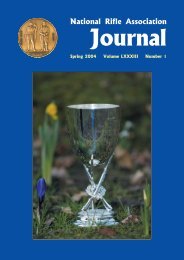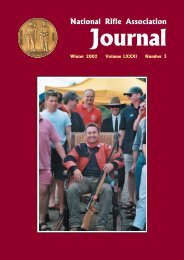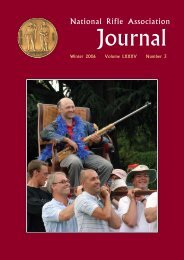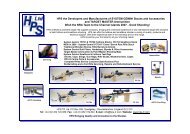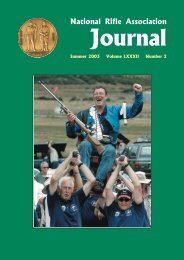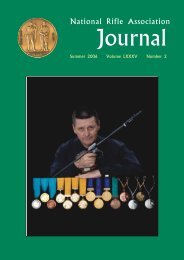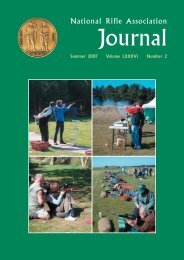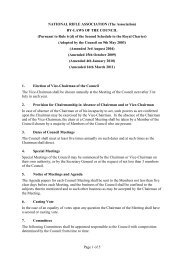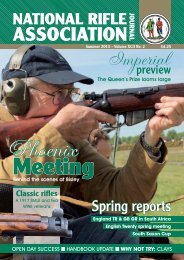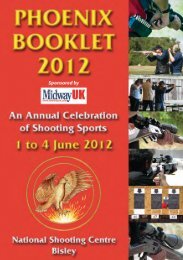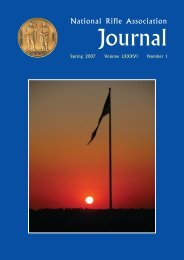NRA Journal - Spring 2011 - National Rifle Association
NRA Journal - Spring 2011 - National Rifle Association
NRA Journal - Spring 2011 - National Rifle Association
You also want an ePaper? Increase the reach of your titles
YUMPU automatically turns print PDFs into web optimized ePapers that Google loves.
Exceptions to the Class system are the Queen’s,George’s and Grand Aggregate. These events are allshot regardless of Class, thus giving a clear indicationof where you came against everyone else. Anotherreason why these three events are particularlysignificant.Some explanation. Her Majesty the Queen’s Prize,instituted by Queen Victoria in 1860, is without doubtthe most prestigious individual rifle competitionanywhere in the world. The format is copied in thenational championships of many countries, and byorganisers of events ranging from club championshipsto the Commonwealth Games. The event is structuredso as to cope with the huge number of competitors inthe fairest way possible. The First Stage (Queen’s I, inthe jargon) is shot in multiple details at three distances(300, 500 and 600 yards) over the course of a day, withcompetitors firing two sighters and seven shots tocount at each distance. This serves as an eliminatorfor the Second Stage (Queen’s II), so scores are notcarried forward. Queen’s II is shot in an afternoon,with 300 qualifiers from the First Stage on the samedetail at each distance, the number of qualifiers beinglimited by the physical dimensions of Century Range.The scores for Queen’s II are processed on the range,and the cut-off for a place in the final Third Stage isannounced within a few minutes. It is usual for thereto be a tie-shoot for the last places in the Final. Thisthird and final stage is the last event of the Meeting,shot at 900 and 1000 yards on Final Saturday afternoonbetween the 100 competitors making the highest scorein the Second Stage. The scores in the Second andThird Stages are added together to decide the winner,who is then carried shoulder-high from the range inprocession led by a military band, and subsequentlycarried round all the Clubhouses on Bisley Camp inan evening of celebration. So if you only enter onecompetition, this should be the one! It’s also the bestvalue for money, as the entry fee is based on the FirstStage only – if you get through to the subsequentstages you have won, amongst any other prizes, a freeshoot and there are many subsidiary prizes decidedon the Queen’s Prize scores.Once you have decided which events you would liketo enter – the main constraints being your resourcesof time and money – you need then to make anentry. This is a subject all by itself – see the factsheet“Imperial Meeting – Making an Entry”. Whether youenter online (easiest) or on paper, the staff will preparean envelope with all the essential documents that youneed in order to participate, and you pick this up onarrival at Bisley in exchange for the receipt they havesent you. For what to do with all the documents seethe briefing sheet in the envelope. And having arrivedat Bisley you will need somewhere to stay. Withapproaching 1500 competitors across all disciplines,accommodation during the Meeting is at a premium.You can camp on the site, or park a touring caravan.You may be able to hire one of the static caravansfrom the owner if he isn’t at the Meeting. Most of thevarious clubhouses have accommodation available totheir members. The <strong>NRA</strong> has dormitories and hutsto rent, and brings in portable cabins. Check pricesand availability on the <strong>NRA</strong> website, or talk to theAccommodation Manager Amanda Vaughan. Thereare also hotels and bed and breakfast establishmentswithin easy driving distance of the Camp.To participate in the competitions you have entered,you need the most important item in your envelopeof paperwork – your squadding cards. These showyou where and when you have to go for your slot onthe ranges, and are your scorecards. Things to do:• Get there with at least 20 minutes to spare.• Keep an eye on the queue at the ammunitionpoint – pick a quieter moment to save time.The squadding card is your authority to drawammunition – take it with you.• Double check you are in the right place and timeon the range.• Set up your equipment behind the firing point,making sure that everything is properly attachedto your rifle and that the sights are correctly setfor the distance at which you are about to shoot.• Move on to the firing point when the rangeofficer tells you to.• Introduce yourself to the other competitors onyour firing point. Do tell them it’s your firstMeeting – almost everybody is only too willingto help you with anything you are unsure of.• If you are unsure, ask. Everybody had to do thisfor the first time. There is a lot to take in andyou can’t be expected to know all the ins andouts just by reading about it.• Wait for the order from your own RCO beforeyou load and carry on.• Keep an eye on everything that happens on yourtarget – you need to notice if someone crossfires,or fires out of turn, or challenges the marking,so you don’t compound the problem.• Keep score for one of your companions on thefiring point, as laid down in Rules 341-349 in the<strong>NRA</strong> Handbook.• Ensure they do the same for you.• At the end of the shoot, wait until everyone onyour target has finished, then check your rifleis clear and present it for checking as laid downin Rule 263. Without disturbing competitorsaround you who may still be firing, exchangescorecards and vacate the firing point.• Hand back any unfired sighters and your emptycases. Sign your scorecard and hand it in. If you37



